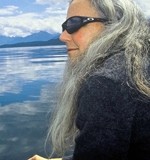Read this feature story from the Seattle Times on BC salmon biologist Alexandra Morton and her work to unmask the harmful diseases associated with the salmon farming industry. (May 26, 2012)
BROUGHTON ARCHIPELAGO, B.C. — She’s perched in her boat near a fish farm, talking about diseases, the kind that might escape and kill wild salmon. Then she spies a worker peeling toward her in a boat.
Alexandra Morton, bane of North America’s salmon farms, runs a hand over tired eyes and awaits a confrontation.
It’s no surprise this eco-provocateur is again in someone’s sights.
The biologist has spent countless days just like this — zipping through a pristine jumble of uninhabited bays and islands to check on Canada’s remote fish farms. Few activists try harder to convince the globe that salmon farming threatens the marine world. Few are taken as seriously — much to the chagrin of her many enemies.
It was Morton who stunned U.S. scientists last fall with trace evidence found in wild salmon of a virus that killed millions of farmed fish in Chile.
Researchers from Washington state to Washington, D.C., scrambled to grasp the risks of so-called infectious salmon anemia (ISA), a virus typically linked to fish farms. Congress demanded federal agencies test American fish. Wild-salmon lovers seethed. Leaders of British Columbia’s $500 million-a-year salmon-farming industry scoffed — in part because they so distrust Morton.
Then, just last week, another virus raced through salmon farms at Vancouver Island and Bainbridge Island, forcing operators to kill hundreds of thousands of farmed fish on both sides of the border. Unlike ISA, this virus, infectious hematopoietic necrosis (IHN), is native to wild Northwest salmon, but experts worry that the clustering of nonnative Atlantic salmon in farm-fish net pens could amplify the pathogen and make it more virulent or cause it to mutate into something far more deadly for wild stocks.
Now, as researchers in both countries struggle to determine if a wild fish-killing pathogen is here or coming, Morton — a Connecticut native and former killer-whale biologist — is everywhere. She’s testifying in Canadian court, blogging about viruses, shuttling about in her sea dory. She gathers farmed-fish heads at ethnic groceries and travels the province teaching groups to sample fish. She hunts for clues to support her belief that Atlantic-salmon farms are big trouble.
Her single-mindedness, bombast and memorable white mane make her a target for an industry sensitive to criticism. (One company sued an activist friend of hers for creating cartoon cigarette packs with the slogan “Salmon Farming Kills Like Smoking.”)
Morton has heard rumors fish-farm workers keep pictures of her boat thumb-tacked to their bulletin boards. The B.C. Salmon Farmers Association dedicates a Web page to correcting Morton’s statements. The B.C. government is considering making it a crime for anyone to release — or a journalist to publish — information about disease outbreaks, including on salmon farms. Fines could reach $75,000.
“Alex hides nothing about the fact that she doesn’t believe in salmon aquaculture,” says Ian Roberts, with Marine Harvest, a seafood company that raises half of B.C.’s farmed salmon. “She’ll go to any length to prove her feelings are justified.”
Already on this windy mid-May morning, Morton has trained her field glasses on a farmed-salmon pen only to find a worker staring back through binoculars. When another farmer warily pulls alongside her boat, Morton turns to her most potent weapon: charm.
“Can I help you guys at all?” he asks.
“We’re just looking,” Morton says cheerily and pumps him for information. “How old are these fish? How long have they been in the water?”
Morton extracts a few nuggets before the man jets away, a victim of Morton’s disarming agreeableness. She shrugs. “It’s not the workers I have a beef with,” she says.
Read more: http://seattletimes.nwsource.com/html/localnews/2018296338_viruslady27m.html



